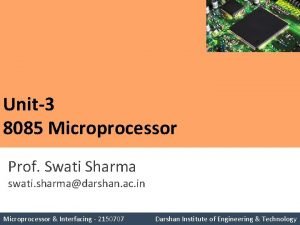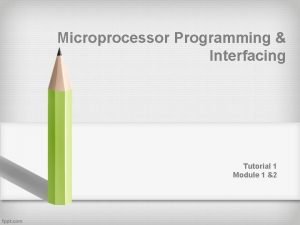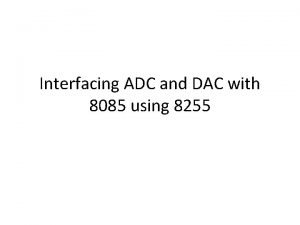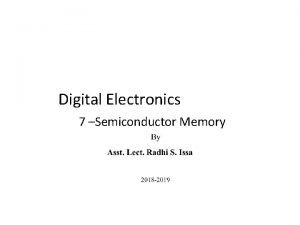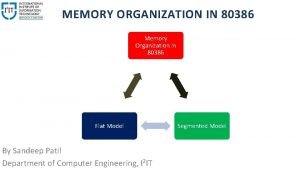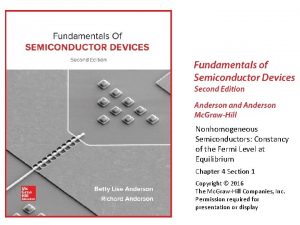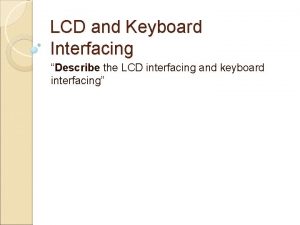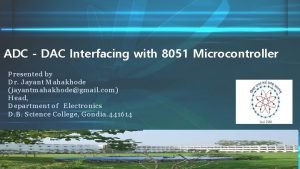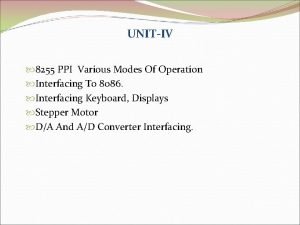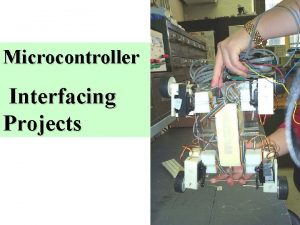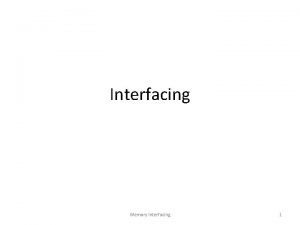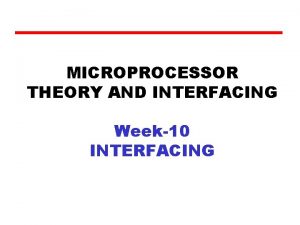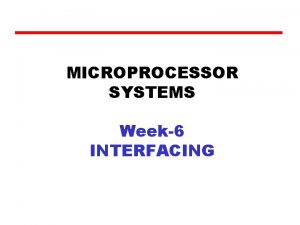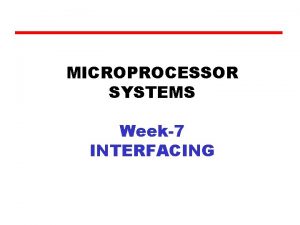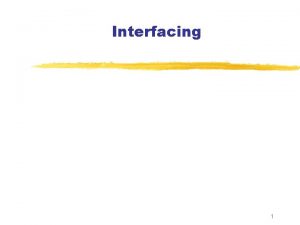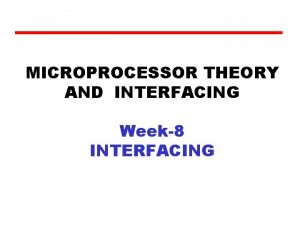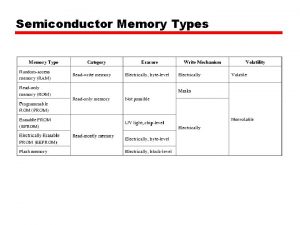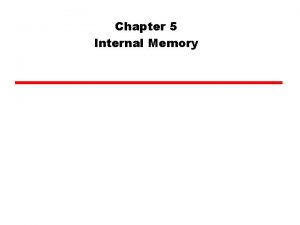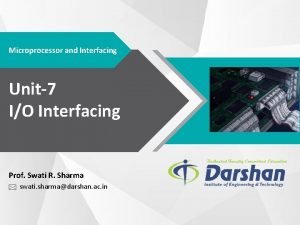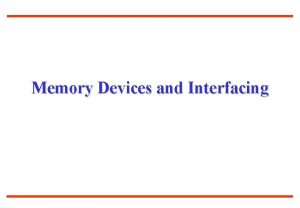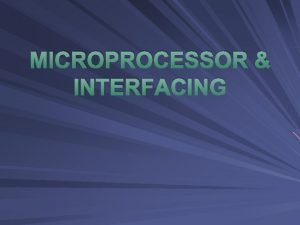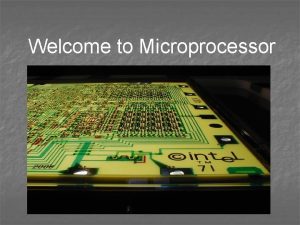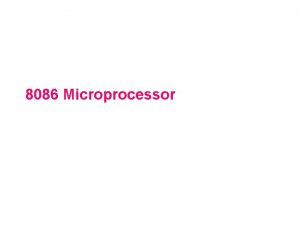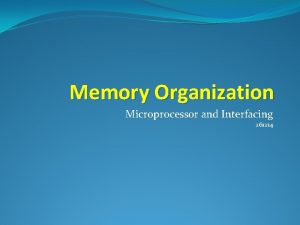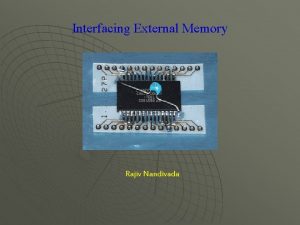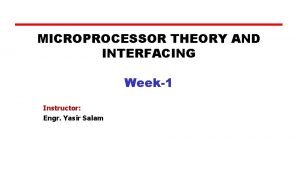MICROPROCESSOR THEORY AND INTERFACING Week7 Semiconductor Memory Types



























- Slides: 27

MICROPROCESSOR THEORY AND INTERFACING Week-7

Semiconductor Memory Types Memory Type Category Random-Access Memory (RAM) Read-write memory Read-only Memory (ROM) Programmable ROM (PROM) Flash Memory Volatile – must be provided with a constant power supply Read-only memory Erasable PROM (EPROM) Electrically Erasable PROM (EEPROM) Volatility Nonvolatile Read-mostly memory

Semiconductor Memory • RAM —Misnamed as all semiconductor memory is random access (as all of the types listed in the previous table) —Read/Write —Volatile —Temporary storage

RAM (Memory Cell Operation) Select terminal – selects a memory cell for read/write operation Control terminal – indicated read or write For writing – data terminal provides an electrical signal that sets state of cell to 1 or 0 For reading – that terminal is used for output of cell’s state

Semiconductor Memory ØRAM technology is divided into two technologies: — Dynamic and Static

Read Only Memory (ROM) • Permanent storage —Nonvolatile • • Microprogramming Library subroutines Systems programs (BIOS) Function tables

Types of ROM • Written during manufacture —Very expensive for small runs • Programmable (once) —PROM —Needs special equipment to program • Read “mostly” —Erasable Programmable (EPROM) – Erased by UV —Electrically Erasable (EEPROM) – Takes much longer to write than read —Flash memory – Erase whole memory electrically

Semiconductor Memory Types PROM Small, written only once, special equipment is required for programming Ø In read-mostly-memory, the Read op are far more frequent than write op EPROM All storage cells must be erased to same initial state by an ultraviolet light, it takes 20 min to perform, can be used multiple times

Semiconductor Memory Types EEPROM That can be written into at any time without erasing prior contents; only byte or bytes addressed are updated. Write op takes longer time than read op, 100 µsec/byte. FLASH MEMORY Ø Kind of Non-volatile random-access memory Ø Slower than RAM but faster than hard drives

INTERFACING MEMORY WITH 8085 Ø Programs and data that are executed by the microprocessor have to be stored in ROM/EPROM and RAM Ø 8085 has 16 address lines (A 0 A 15) Maximum of 64 KB (= 2^16 bytes) of memory locations can be interfaced Ø Memory address space takes values from 0000 H to FFFFH Ø IO/M , RD and WR when it wants to read from and write into memory or I/O devices

INTERFACING MEMORY WITH 8085 Ø CE or CS(chip enable or chip select) Ø OE or RD (output enable or read) Ø WE or WR (write enable or write)

INTERFACING MEMORY WITH 8085 Generation of Control Signals for Memory 8085 activates IO/M , RD and WR signals as shown in the Table

INTERFACING MEMORY WITH 8085 Ø Using IO/M , RD and WR two control signals MEMR(memory read) and MEMW(memory write)

INTERFACE AN IC 2764 WITH 8085 Specification of IC 2764: Ø 8 KB (8 x 2^10 byte) EPROM chip Ø 13 address lines (2^13 bytes = 8 KB) Ø Address range allocated to the chip is 0000 H – 1 FFFH

INTERFACE AN IC 2764 WITH 8085 Ø 13 address lines of IC are connected to A 0 -A 12 Ø Remaining (A 13, A 14, A 15) are connected to address decoder formed using logic gates Ø Output of decoder is connected to the CE pin of IC Ø Chip is enabled whenever the 8085 places an address allocated to EPROM chip in the address bus

INTERFACE AN IC 2764 WITH 8085

INTERFACE AN IC 2764 WITH 8085

EXAMPLES OF MEMORY INTERFACING EXAMPLE-2 Consider a system in which the full memory space 64 KB is utilized for EPROM memory. Interface the EPROM with 8085 processor. Ø The memory capacity is 64 Kbytes. i. e. 2^n = 64 x 1024 bytes Ø where n = address lines. So, n = 16. Ø In this system the entire 16 address lines of the processor are connected to address input pins of memory IC in order to address the internal locations of memory.

EXAMPLES OF MEMORY INTERFACING EXAMPLE-2 Ø The chip select (CS) pin of EPROM is permanently tied to logic low (i. e. , tied to ground). Ø Since the processor is connected to EPROM, the active low RD pin is connected to active low output enable pin of EPROM. Ø The range of address for EPROM is 0000 H to FFFFH.

EXAMPLES OF MEMORY INTERFACING EXAMPLE-2

EXAMPLES OF MEMORY INTERFACING EXAMPLE-3 Consider a system in which the available 64 KB memory space is equally divided between EPROM and RAM. Interface the EPROM and RAM with 8085 processor. Ø Implement 32 KB memory capacity of EPROM usingle IC 27256. Ø 32 KB RAM capacity is implemented usingle IC 62256. Ø The 32 KB memory requires 15 address lines and so the address lines A 0 - A 14 of the processor are connected to 15 address pins of both EPROM and RAM.

EXAMPLES OF MEMORY INTERFACING EXAMPLE-3 Ø The unused address line A 15 is used as to chip select. If A 15 is 1, it select RAM and If A 15 is 0, it select EPROM. Ø Inverter is used for selecting the memory. Ø The memory used is both Ram and EPROM, so the low RD and WR pins of processor are connected to low WE and OE pins of memory respectively. Ø The address range of EPROM will be 0000 H to 7 FFFH and that of RAM will be 8000 H to FFFFH.

EXAMPLES OF MEMORY INTERFACING EXAMPLE-3

EXAMPLES OF MEMORY INTERFACING EXAMPLE-4 Consider a system in which 32 KB memory space is implemented using four numbers of 8 KB memory. Interface the EPROM and RAM with 8085 processor. Ø The total memory capacity is 32 KB. So, let two number of 8 KB memory be EPROM and the remaining two numbers be RAM. Ø Each 8 KB memory requires 13 address lines and so the address lines A 0 - A 12 of the processor are connected to 13 address pins of all the memory.

EXAMPLES OF MEMORY INTERFACING EXAMPLE-4 Ø The address lines and A 13 - A 14 can be decoded using a 2 -to-4 decoder to generate four chip select signals. Ø These four chip select signals can be used to select one of the four memory IC at any one time. Ø The address line A 15 is used as enable for decoder. Ø The simplified schematic memory organization is shown.

MEMORY INTERFACING WITH 8085 DECODER:

REVIEW
 8085 pins
8085 pins Microprocessor and interfacing tutorial
Microprocessor and interfacing tutorial Adc and dac interfacing with 8255
Adc and dac interfacing with 8255 Memory interfacing
Memory interfacing Types of memories in digital electronics
Types of memories in digital electronics Semiconductor main memory
Semiconductor main memory Physical memory organization
Physical memory organization 2 types of semiconductor
2 types of semiconductor Internal memory and external memory
Internal memory and external memory Primary memory and secondary memory
Primary memory and secondary memory Virtual memory
Virtual memory Semantic memory example
Semantic memory example Excplicit memory
Excplicit memory Long term memory vs short term memory
Long term memory vs short term memory Physical address vs logical address
Physical address vs logical address Which memory is the actual working memory?
Which memory is the actual working memory? Virtual memory in memory hierarchy consists of
Virtual memory in memory hierarchy consists of Eidetic memory vs iconic memory
Eidetic memory vs iconic memory Symmetric shared memory architecture
Symmetric shared memory architecture Lcd and keyboard interfacing
Lcd and keyboard interfacing Cse 325
Cse 325 8051 interfacing to adc and dac
8051 interfacing to adc and dac Adc and dac interfacing with 8051
Adc and dac interfacing with 8051 Software interrupts in 8085
Software interrupts in 8085 Stepper motor interfacing with 8255
Stepper motor interfacing with 8255 Interfacing adc with 8086
Interfacing adc with 8086 Diagram perencanaan sdm
Diagram perencanaan sdm Interfacing projects
Interfacing projects
